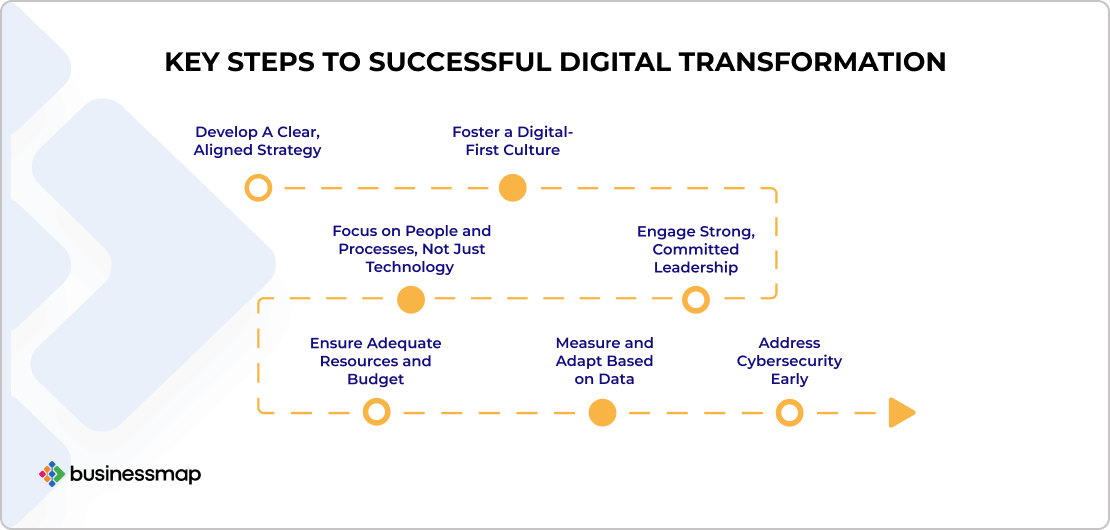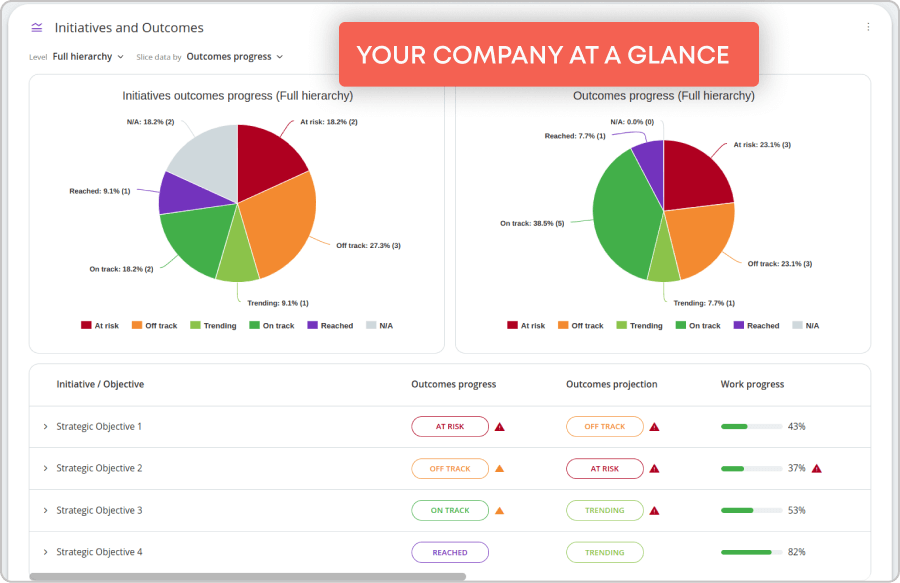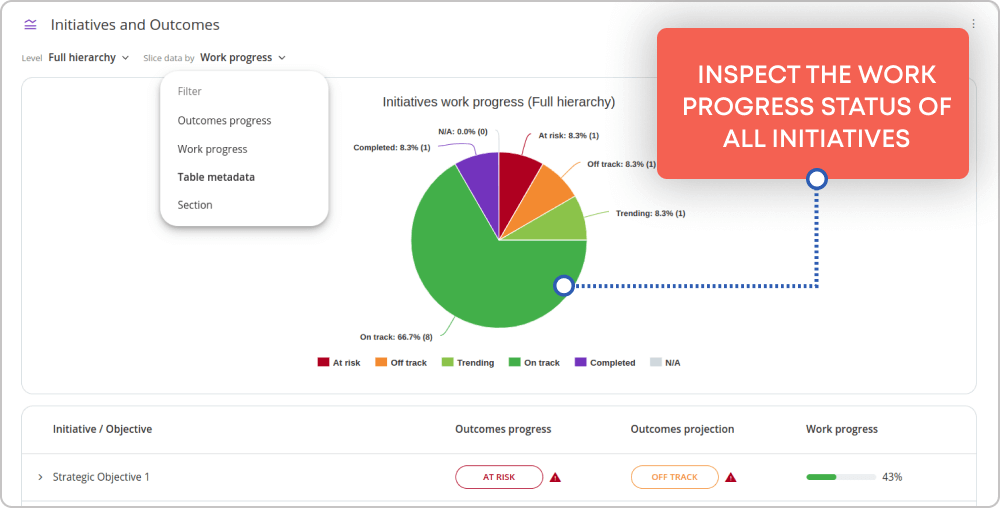Digital transformation has become the top priority on the strategic agenda for every organization—whether in the private sector or government. The digitalization of processes, services, and customer interactions now impacts every aspect of our lives, and organizations can no longer afford to ignore it. Digital transformation is not just a trend; it is one of the most powerful forces shaping the future of business, driving enhanced efficiencies, superior customer experiences, and the ability to rapidly adapt to shifting market demands.
However, despite the high stakes and significant investments, a vast majority of digital transformation initiatives fail to meet their objectives. Studies from McKinsey and Forbes show that 70-80% of digital transformation projects fall short of their goals.
In this article, we briefly address the most common reasons why digital transformation initiatives fail, helping shed light on the critical mistakes organizations must avoid succeeding in their digital journeys.
8 Biggest Mistakes that Lead to Digital Transformation Failure
Digital transformation projects often fail due to common critical mistakes that block success in achieving your organization’s strategic goals. Let’s explore these pitfalls and discover how to overcome them for a successful transformation.
1. Lack of Clear Strategy and Vision
One of the most common reasons for digital transformation failure is the absence of a well-defined strategy for the digital transition. Many companies rush into digital projects without a clear understanding of what they hope to achieve. They might invest in the latest technologies, but without a coherent plan, these tools often fail to deliver value.
2. Resistance to Change and Poor Organizational Culture
Digital transformation often fails due to resistance from employees. Many people fear change, especially when it involves new technologies and processes. If employees are not on board with the transformation, even the most advanced tools will not reach their full potential.
A related issue is the lack of a digital-first culture. Companies with a rigid, risk-averse culture may resist adopting new ways of thinking and working, which can slow down or derail the transformation process.
3. Ineffective Leadership
Digital transformation requires strong, committed leadership to drive the initiative forward. Failure occurs when leadership is not fully aligned, lacks the necessary digital literacy, or is not committed to making difficult decisions. Additionally, siloed leadership, where departments work independently without coordination, can hinder progress.
4. Overemphasis on Technology, Not on People and Processes
A common mistake in digital transformation is focusing too heavily on the technology itself rather than the people and processes it impacts. While new technologies such as AI, machine learning, and cloud computing are critical, they are only tools. Success depends on how well these tools are integrated into the organization’s operations and how they enhance workflows.
5. Inadequate Resources and Budgeting
Many companies underestimate the resources and budget required for a successful digital transformation. This leads to underfunded initiatives that are unable to scale or meet business needs. In some cases, organizations fail to allocate enough resources for ongoing maintenance and support after the initial implementation.
6. Failure to Adapt and Scale
Digital transformation initiatives often start strong but fail when it comes to scaling across the organization. Some projects may only be piloted in one department and never expanded company-wide, while others may not be flexible enough to adapt to future needs or market changes.
7. Ignoring Data and Metrics
Without clear metrics to track the progress of a digital transformation initiative, it’s impossible to know whether the project is successful. Many organizations fail to define what success looks like in concrete terms, leading to ambiguous results and a lack of accountability.
8. Underestimating Cybersecurity Risks
As organizations digitize their operations, they become more vulnerable to cybersecurity risks. Failing to address these risks during digital transformation can lead to costly data breaches, downtime, and a loss of customer trust. Implementing proactive security measures, like Dark Web Monitoring, helps detect exposed credentials and security gaps before they become costly problems.
Make it Happen: 7 Essential Steps for Thriving Digital Transformation
To avoid these common pitfalls and ensure your digital transformation delivers the expected value, consider the following action steps:

1. Develop a Clear, Aligned Strategy
- Action: Start with a well-defined digital transformation roadmap that aligns with your organization’s overarching goals. Make sure the strategy is not just tech-driven, but also focused on how digital initiatives will improve business outcomes.
- Tools: Use strategic planning frameworks like Balanced Scorecard or SWOT Analysis to ensure alignment between digital initiatives and business goals. Digital project management platforms like Businessmap, Microsoft Project or Asana can help manage the execution of these strategies.
2. Foster a Digital-First Culture
- Action: Build a culture that embraces digital transformation by promoting openness to change, continuous learning, and innovation. Encourage collaboration across departments and break down silos that may resist new digital practices.
- Tools: Digital solutions can enhance communication and collaboration across teams, ensuring that everyone is aligned and working toward the same digital goals.
3. Engage Strong, Committed Leadership
- Action: Appoint a Chief Digital Officer (CDO) or other leadership roles responsible for overseeing the digital transformation process. Leadership should actively champion the initiative, breaking down silos and ensuring cross-departmental collaboration.
- Tools: Use executive dashboards from tools like Power BI, Tableau or seek integration with your preferred solutions, to keep leadership informed on progress and challenges, ensuring data-driven decisions at every step.
 Using executive management dashboards in Businessmap
Using executive management dashboards in Businessmap
4. Focus on People and Processes, Not Just Technology
- Action: Digital transformation is about more than just implementing the latest tools. Rethink business processes, invest in employee training, and ensure the workforce is equipped to make the most of new technologies.
- Tools: Use Change Management tools like Prosci’s ADKAR Model or Kotter’s 8-Step Process for Leading Change to help manage the human side of transformation. Learning platforms like Coursera or Udemy for Business can provide the necessary upskilling.
5. Ensure Adequate Resources and Budget
- Action: Carefully plan and allocate resources, ensuring that the transformation is properly funded not only for implementation but also for ongoing maintenance and scaling.
- Tools: Financial planning tools like Anaplan or Oracle Hyperion can help in budgeting and resource allocation, ensuring the initiative stays within scope and delivers long-term value.
6. Measure and Adapt Based on Data
- Action: Set clear KPIs and track progress regularly to ensure the transformation is on the right path. Be prepared to pivot based on the data and feedback.
- Tools: Utilize analytics platforms like Google Analytics, Power BI, or Looker to track the success of your initiatives in real-time. This will help you identify areas for improvement and make data-driven adjustments.
 Monitoring the progress of ongoing initiatives in real-time in Businessmap
Monitoring the progress of ongoing initiatives in real-time in Businessmap
7. Address Cybersecurity Early
- Action: Incorporate cybersecurity into every aspect of your digital transformation to protect your digital assets and build trust with customers.
- Tools: Use cybersecurity solutions like Palo Alto Networks, CrowdStrike, or FireEye to safeguard your digital infrastructure from the onset of the transformation process.
A Takeaway to Remember!
While digital transformation holds immense potential to revolutionize organizations, it is fraught with challenges that can derail even the most ambitious initiatives. The key takeaway for leaders is this: Digital transformation is not just about technology - it’s about aligning technology with the broader business strategy, fostering a culture of adaptability, and empowering people to embrace change.
Ignoring these factors explains why digital transformation fails so often, leading to the high rate of unsuccessful initiatives.
Businessmap is the most flexible software, helping your company gain visibility across all projects/portfolios, align on goals, and deliver quality work faster.

Tony Prensa
CEO and Founder of TP Global Business Consulting
Tony Prensa is a distinguished professional in project management, information technology, and software engineering, boasting over 40 years of experience across diverse industrial sectors. Tony has extensively worked on creating and optimizing PMOs, utilizing agile methodologies, Lean, Six Sigma, and digital transformation.



